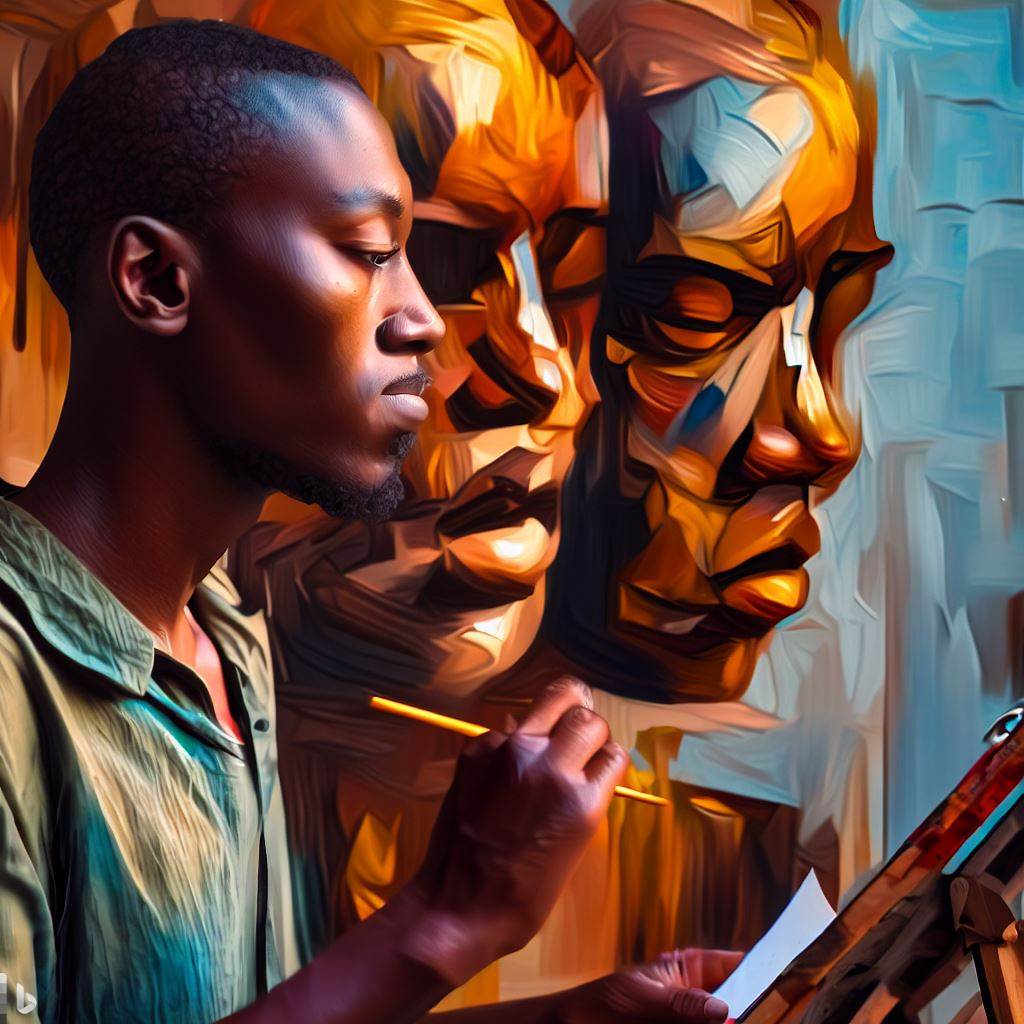Art Movements in Nigeria: A Comprehensive Review
Last Updated on September 2, 2023
Introduction
A. Exploring Nigeria’s Art Movements
Delving into Nigeria’s rich artistic heritage is vital for understanding its cultural evolution.
This blog aims to comprehensively review the influential art movements shaping Nigeria’s vibrant art scene.
B. Importance of Art Movements
Studying art movements in Nigeria uncovers the cultural, social, and political contexts that inspired artists.
C. Overview of Nigeria’s Artistic Heritage
Nigeria boasts a diverse artistic legacy, from ancient Nok sculptures to contemporary multimedia expressions.
D. Thesis Statement
This blog post endeavors to provide a thorough examination of the myriad art movements that have left an indelible mark on Nigeria’s dynamic art landscape.
Pre-Independence Art Movements
A. Overview of art movements prior to Nigeria’s independence in 1960
During the pre-independence era, Nigeria witnessed a number of significant art movements that laid the foundation for its vibrant artistic culture.
Artists, inspired by their indigenous traditions, explored various styles and techniques to express their cultural identities.
These art movements not only served as a means of self-expression but also as a way to resist colonial influence.
In this section, we will delve into the key art movements that emerged before Nigeria attained independence.
B. Colonial influence on Nigerian art
The colonial era had a profound impact on Nigeria’s art scene, shaping and influencing its artistic expressions.
European styles and techniques were introduced to Nigerian artists, leading to a fusion of traditional and Western elements in their works.
This amalgamation of influences created a unique artistic identity that reflected both the richness of Nigerian culture and the impact of colonization.
We will explore how Nigerian artists responded to these influences and the ways in which they incorporated them into their artistic practices.
C. Yaba School and its impact
The Yaba School of Art, established in 1957, played a pivotal role in the development of Nigerian art.
Under the guidance of renowned artists and educators, the school provided a platform for artistic training and experimentation.
Many influential Nigerian artists emerged from the Yaba School, contributing to the evolution of Nigerian art movements.
We will closely examine the impact of this institution on the Nigerian art scene and the artists it nurtured.
D. The Zaria Art Society
The Zaria Art Society, formed in the 1960s, was a significant art movement that emerged after Nigeria’s independence.
It sought to promote the use of indigenous materials and art forms in response to the dominance of Western styles.
The Zaria Art Society not only laid the foundation for contemporary Nigerian art but also influenced art movements across Africa.
We will delve into the principles, objectives, and impact of the Zaria Art Society on Nigeria’s art landscape.
Read: Nigerian Musicians: Achieving Success Abroad
Contemporary Art Movements
A. Introduction to contemporary art movements that emerged post-independence
Contemporary art movements in Nigeria have played a significant role in shaping the country’s artistic landscape.
These movements emerged post-independence, reflecting the changing socio-political climate and the artists’ desire to express their individual and collective identities.
B. Nsukka Art School and its role in shaping Nigerian art
The Nsukka Art School is one of the notable contemporary art movements that emerged during this period.
Established in 1963 at the University of Nigeria, Nsukka, the art school became a hub for artists seeking to explore and express their cultural heritage.
The school emphasized a fusion of traditional Nigerian art techniques with modern approaches, leading to the development of a distinct Nsukka art style.
The Nsukka Art School played a crucial role in shaping Nigerian art by providing a platform for artists to showcase their works both nationally and internationally.
It also contributed to the preservation and promotion of Nigerian cultural heritage through its emphasis on traditional artistic techniques and themes.
C. Oshogbo Art Movement and its influence on national identity
Another prominent contemporary art movement is the Oshogbo Art Movement, which originated in the 1960s in the southwestern city of Oshogbo.
This movement was characterized by its focus on mythological and Yoruba religious themes, using vibrant colors and intricate designs.
The Oshogbo Art Movement played a significant role in shaping Nigerian national identity by highlighting the importance of cultural heritage and indigenous beliefs.
D. Neo-Tokyo group and their approach to art-making
The Neo-Tokyo group, founded in the 1990s, represents a more recent development in Nigerian contemporary art.
This group of artists, inspired by Japanese anime and manga, adopted a unique approach to art-making.
They combined traditional Nigerian themes with contemporary elements, creating a fusion of cultures that resonated with the younger generation.
The Neo-Tokyo group’s innovative approach challenged traditional notions of Nigerian art and pushed the boundaries of artistic expression.
E. The contemporary trends in Nigerian art
Contemporary trends in Nigerian art continue to evolve, reflecting the dynamism of the country’s artistic landscape.
Notable trends include the use of mixed media, installation art, and the exploration of socio-political issues. Artists are also increasingly embracing technology and digital art as a means of expression.
These trends reflect the artists’ desire to engage with the current realities facing Nigeria and address pressing societal concerns.
Ultimately, contemporary art movements in Nigeria have played a vital role in shaping the country’s artistic landscape.
The Nsukka Art School, Oshogbo Art Movement, and the Neo-Tokyo group have contributed to the development of a vibrant and diverse art scene.
Nigerian artists continue to explore new artistic approaches and trends, reflecting the ever-changing socio-political climate in the country.
The future of Nigerian contemporary art is promising, as artists navigate the complexities of tradition and modernity to create meaningful and impactful works.
Read: Successful Music Collaborations in Nigeria’s History
Significant Artists and their Contributions
Highlighting key artists from different art movements and discussing their artistic styles and techniques, as well as analyzing their contributions to the Nigerian art scene.
Notable artists to include: Ben Enwonwu, Bruce Onobrakpeya, El Anatsui, Ndidi Dike, etc.
A. Ben Enwonwu
Considered one of Nigeria’s most influential artists, Ben Enwonwu was a pioneer of the Nigerian art movement.
He is best known for his sculpture “Anyanwu” and his iconic portrait of Queen Elizabeth II.
Enwonwu’s artistic style combined elements of traditional African art with Western techniques, creating a unique blend of cultural influences.
His contributions to the Nigerian art scene helped pave the way for future generations of artists.
B. Bruce Onobrakpeya
Bruce Onobrakpeya is a prominent figure in Nigerian art, known for his printmaking and mixed-media artworks.
His artistic style is characterized by intricate patterns, vibrant colors, and a focus on Nigerian folklore and mythology.
Onobrakpeya’s contributions to the Nigerian art scene include the establishment of the Harmattan Workshop, which provided a platform for artists to exchange ideas and collaborate.
C. El Anatsui
El Anatsui is a Ghanaian-born artist who has made significant contributions to the Nigerian art scene.
His signature style involves transforming everyday materials, such as discarded bottle caps and aluminum, into large-scale installations.
Anatsui’s artworks address issues of consumerism, globalization, and African identity.
His innovative use of materials and his thought-provoking themes have garnered international acclaim, making him one of Africa’s most celebrated contemporary artists.
D. Ndidi Dike
Ndidi Dike is a Nigerian artist known for her mixed-media installations that explore themes of identity, history, and cultural heritage.
Her artistic style incorporates found objects, textiles, and traditional artistic techniques.
Dike’s contributions to the Nigerian art scene include her involvement in artist-led initiatives and her advocacy for the recognition of women artists in Nigeria.
She is also a mentor to younger artists, inspiring them to explore their own creative voices.
E. Yusuf Grillo
Yusuf Grillo is a renowned Nigerian artist who has greatly influenced the Nigerian art scene.
His artistic style combines realism with elements of traditional African art, resulting in vibrant and colorful paintings.
Grillo’s contributions extend beyond his own artwork, as he played a pivotal role in the establishment of the Zaria Art Society, which propelled the development of modern art in Nigeria.
He is considered a pioneer of the “Zaria School” of art.
F. Nike Davies-Okundaye
Nike Davies-Okundaye is a well-known Nigerian textile artist and curator.
She specializes in the traditional Yoruba art of textile dyeing and weaving, known as adire.
Davies-Okundaye’s artistic style is characterized by intricate patterns and vibrant colors.
Her contributions to the Nigerian art scene include preserving and promoting traditional African art forms, as well as empowering local artisans through her art centers and workshops.
G. Peju Alatise
Peju Alatise is a contemporary Nigerian artist known for her sculptures, paintings, and installations.
Her artistic style often explores themes of gender, identity, and social issues.
Alatise’s contributions to the Nigerian art scene include representing Nigeria at the 57th Venice Biennale in 2017, where she showcased her thought-provoking installation titled “Flying Girls.”
She continues to challenge societal norms through her art and provide a platform for dialogue and reflection.
In fact, these significant artists have made profound contributions to the Nigerian art scene.
Through their unique artistic styles, techniques, and thought-provoking themes, they have helped shape and define Nigerian art.
Their works continue to inspire future generations of artists and contribute to the rich cultural heritage of Nigeria.
Read: A Guide to Cinematography Equipment in Nigeria

Impact of Art Movements on Nigerian Culture and Society
In this section, we will explore the profound influence art movements in Nigeria have had on the country’s culture and society.
A. How these art movements have influenced the Nigerian culture
Art movements in Nigeria have played a significant role in shaping and preserving the country’s cultural heritage.
- Through various artistic expressions, these movements have celebrated Nigeria’s rich traditions and customs.
- Artworks have become a medium for Nigerians to connect with their cultural roots and pass down ancestral knowledge.
- The vibrant colors, patterns, and motifs used in Nigerian art reflect the diversity and richness of its culture.
B. The role of art in addressing socio-political issues
Art has served as a powerful tool for Nigerian artists to address and critique socio-political issues.
- Art movements like the Zaria Art Society emerged during a period of political turmoil and colonialism.
- These artists used their works to protest against social injustices and advocate for independence.
- The Oshogbo Art Movement also used art to challenge societal norms and advocate for cultural revival.
C. The impact on the global art market
The Nigerian art movements have not only shaped the local art scene but have also made an impact on the global art market.
- The rise of Nigerian contemporary art has garnered international attention and recognition.
- Nigerian artists, such as Ben Enwonwu and Njideka Akunyili Crosby, have achieved worldwide acclaim.
- Nigerian art is now being showcased in prestigious galleries and museums around the world.
- Collectors and art enthusiasts are increasingly drawn to Nigerian artworks, leading to a surge in demand.
D. International recognition and exhibitions of Nigerian art
Nigerian art has been showcased in numerous international exhibitions, further establishing its significance in the art world.
- The “African Art: The Masterpiece” exhibition at the Centre Pompidou in Paris featured Nigerian artists.
- Documenta 14, one of the world’s most renowned art exhibitions, included works by Nigerian artists.
- The inclusion of Nigerian art in prestigious events globally highlights its recognition and value.
- These exhibitions provide a platform for Nigerian artists to showcase their talent and cultural heritage.
Overall, the art movements in Nigeria have left a lasting impact on the country’s culture, society, and the global art scene.
Through their artistic expressions, Nigerian artists have celebrated their cultural heritage, addressed socio-political issues, and gained international recognition.
The influence of these movements continues to shape the Nigerian art landscape and contribute to the preservation of its rich cultural identity.
Read: Nollywood: Music and Soundtracks in Focus
Challenges Faced by Nigerian Artists and Art Movements
Nigerian artists and their movements possess boundless creativity but grapple with profound challenges.
Funding and infrastructure woes plague the vibrant Nigerian art scene, while global recognition remains elusive.
This section delves into these hardships and also uncovers the commendable efforts striving to mend these gaps.
A. Funding and Infrastructure
Financial limitations shackle many Nigerian artists. Procuring quality materials and studio spaces can be an uphill battle.
Galleries, especially outside major cities like Lagos, often struggle to meet basic exhibition needs. The government’s support in this aspect falls short of nurturing the blossoming art culture.
Infrastructure too is a stumbling block. A dilapidated road leading to an artist’s studio can hinder their creative process. Inadequate storage facilities for valuable art pieces pose a risk.
These infrastructural limitations not only dampen artistic spirits but also jeopardize art preservation.
B. Limited Visibility and Recognition
Despite the vibrant creativity found in Nigeria’s art scene, its global recognition often falls short. Nigerian artists yearn for the international platform to showcase their talent.
The world remains oblivious to their unique narratives, rich cultural expressions, and innovative techniques.
This limited visibility stems partly from a lack of global promotion and representation. The art market’s focus on Western art has historically sidelined Nigerian art.
Museums and galleries abroad have been slow to embrace African contemporary art. The global art discourse needs to open its doors to Nigeria’s vivid artistic tapestry.
C. Efforts to Address Challenges
Amid these challenges, Nigerian artists and art movements have shown resilience and determination.
Initiatives like art grants, fellowships, and artist-in-residence programs have begun to ease financial burdens. Art-focused NGOs and foundations have emerged to provide platforms and resources for artists.
Furthermore, the Nigerian government is gradually recognizing the value of art in its cultural heritage and economy. Investments in cultural infrastructure and education are slowly gaining traction.
However, more substantial support is needed to harness the full potential of the nation’s artistic wealth.
Internationally, Nigerian artists are taking matters into their own hands. They network with global artists, curators, and collectors.
They leverage social media and digital platforms to showcase their work to a wider audience. Nigerian art is slowly but steadily gaining international acclaim.
Basically, Nigerian artists and art movements grapple with financial constraints, inadequate infrastructure, and limited global recognition.
However, their indomitable spirit, coupled with growing support from within and outside Nigeria, offers hope for a brighter future.
As funding becomes more accessible and infrastructure improves, the world will witness the full brilliance of Nigerian art.
With persistence and resilience, Nigerian artists are determined to conquer these challenges and continue enriching the global art landscape.
Conclusion
This blog post provided a comprehensive review of art movements in Nigeria, highlighting their significance and impact.
We discussed the major art movements that emerged in Nigeria, such as the Zaria Art Society and the Nsukka Art School.
These movements not only fostered artistic innovation but also played a pivotal role in promoting cultural identity and national pride.
By exploring Nigerian art, readers can gain a deeper understanding of the country’s rich artistic heritage and its contribution to the global art scene.
It is crucial to recognize the immense potential of Nigerian art and its ability to challenge societal norms, inspire change, and express diverse narratives.
Looking towards the future, Nigerian art holds great promise in making a lasting impact, both locally and internationally.
Art enthusiasts, scholars, and collectors are encouraged to delve further into Nigerian art, supporting and nurturing its growth.
As Nigerian artists continue to push boundaries and explore new artistic frontiers, it is an exciting time to witness the dynamic evolution of Nigerian art.
In the end, Nigerian art movements will continue to shape the art world, making significant contributions to the global cultural landscape.


